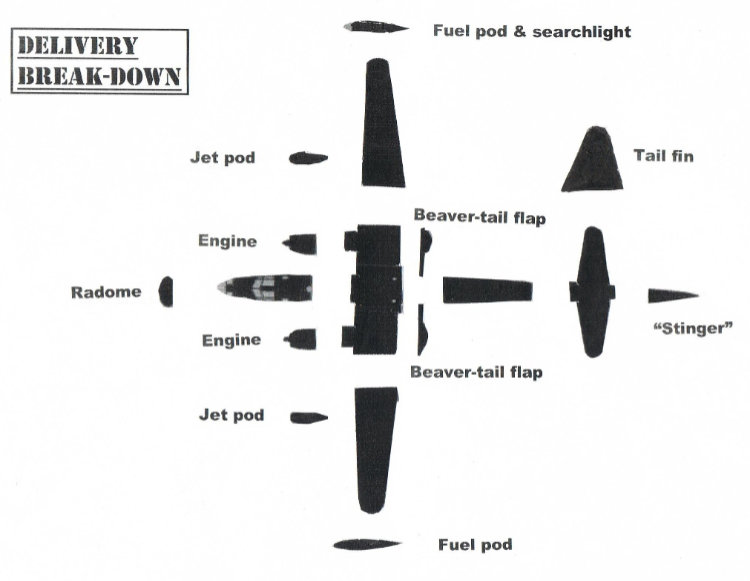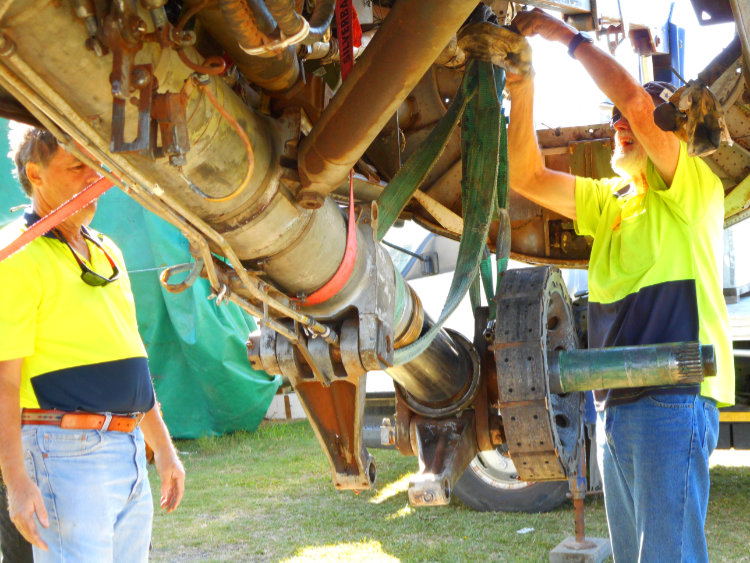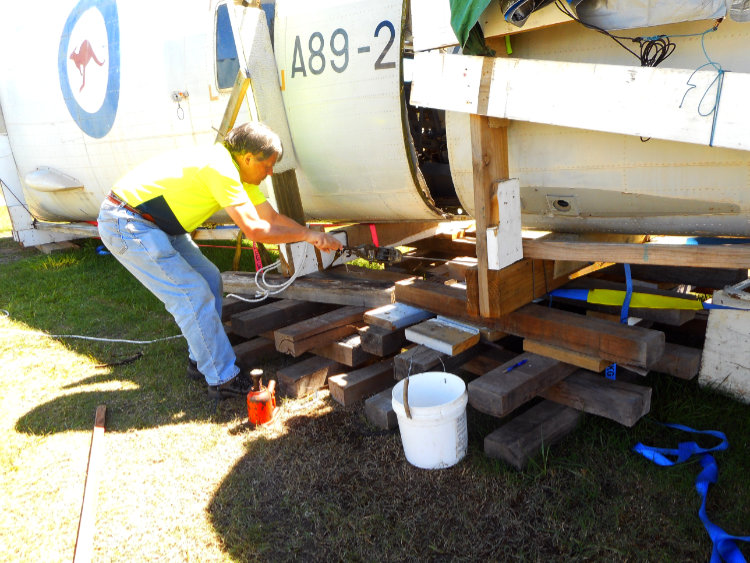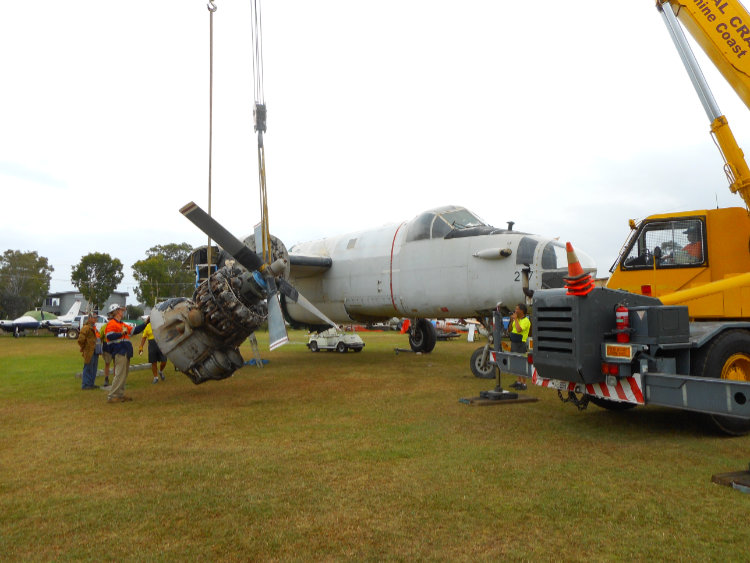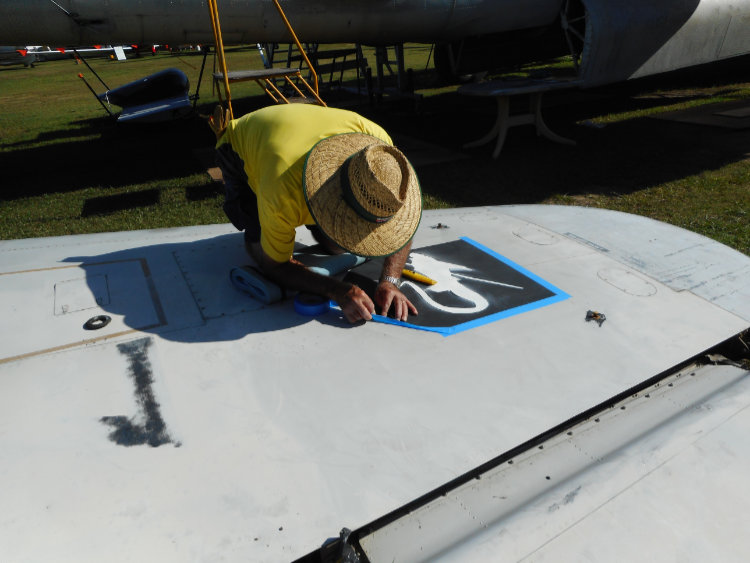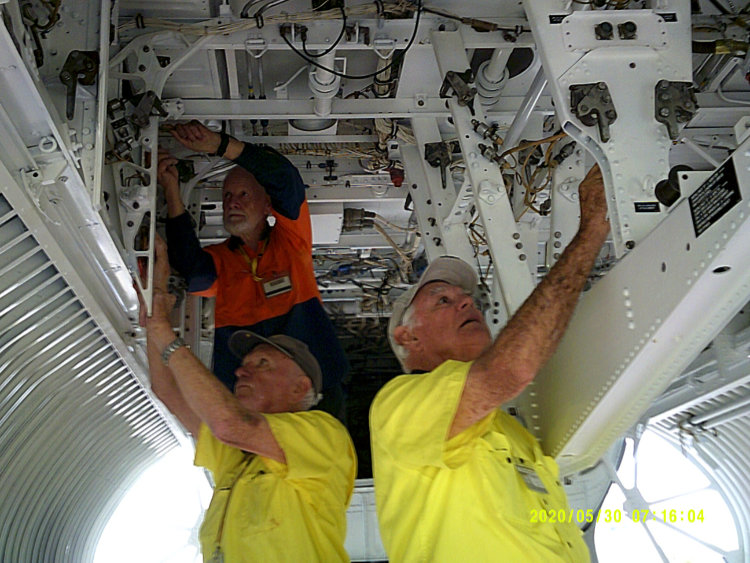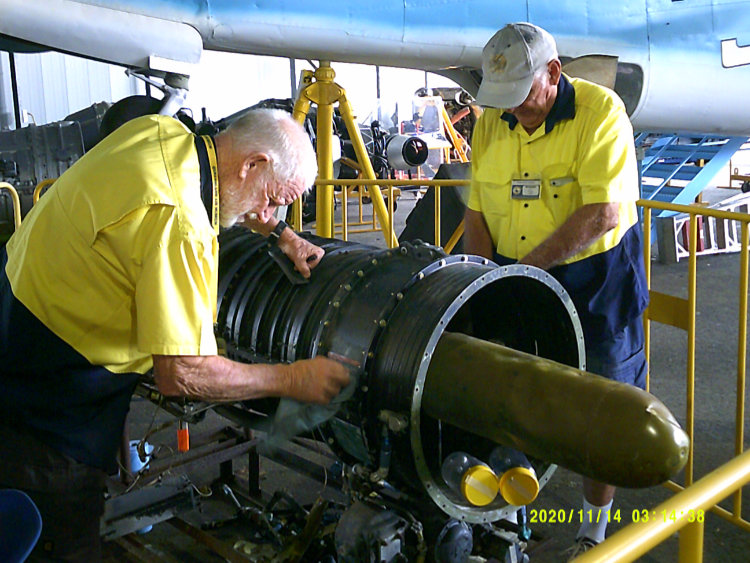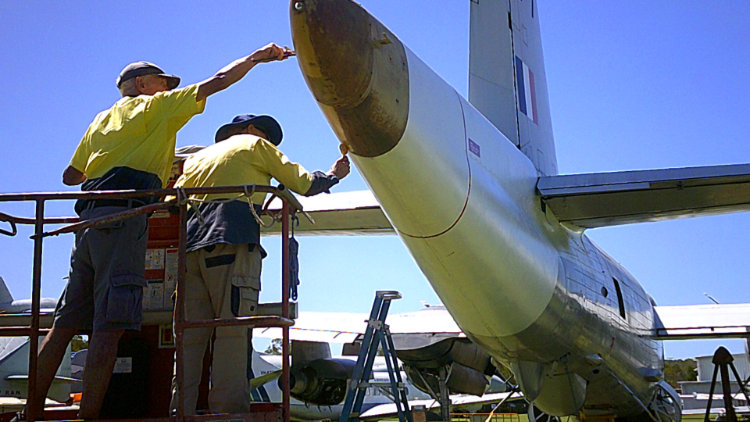by The Team
KING NEPTUNE:
As this is being written, much of the Neptune is already at Caloundra
with the remainder expected to arrive in early March. Before we
could contemplate moving the aeroplane, we had to pay for it!
It is most pleasing to report that this was achieved in a remarkably
short time thanks to some excellent trading days over Christmas/New
Year. We thank our front desk slaves for being there to rake it
in! We also thank Peter Graves for a significant donation towards
the cost of the acquisition. (It will be remembered that Peter
also assisted us with the purchase of the Iroquois). The following
report on the Neptune recovery has been compiled from notes supplied
by former Mareeba boy Geoff Webber who participated in the recovery
in several roles, including that of official scribe/photographer.
Geoff also gave distinguished service as Chief Cook although it's
doubtful if he washed any bottles!
NEPTUNE RECOVERY:
A call for volunteers to recover the Neptune resulted in a team
of 14 of which 9 flew to Cairns on Saturday 6th February, 4 drove
and 1 went by train. Although some may have been tempted to think
that the project was overstaffed, as it turned out, all fourteen
were fully occupied (and exhausted!) during the planned one week
recovery. We must make special mention of Bob Meredith who drove
the QAM truck and trailer from Caloundra to Mareeba with tools,
ladders, generator, compressor, marquee, eskies and all necessary
equipment that couldn't go as airline baggage or which might be
frowned upon as cabin baggage. It was Bob's choice to go solo
and despite initial reservations it was realised that this is
what Bob has done for much of his working life so he was cleared
to depart subject to regular sitreps.
The team was based at a motel conveniently located 5km from the
Beck Museum. The work day started at 7am with departure from the
motel via a hired 12 seater bus. The Beck Museum kindly provided
access to toilet facilities and opened and secured the work site
each day.
Weather on most days was fine, hot and sunny. Temperatures soared
above 30C with humidity ranging from 55% to 90% depending on time
of day. Brief showers interrupted preparations on the final day
causing some concern. However, the only heavy rain occurred on
Thursday around 1.30pm halting crane progress for approximately
one hour.
Power on site was provided by the QAM generator and a compressor
for power tools. Ducted fans were set up to provide adequate ventilation
for those working inside the confined fuselage compartments. Bottled
water was provided to all workers on a regular basis to avoid
the risk of dehydration.
Most volunteers provided their own breakfast supplies at the motel.
Lunches were prepared on site each day and paid by volunteer contribution.
The menu consisted of a variety of healthy cold meats, salads,
fruit and vegetables, buttered bread rolls. Tea, coffee, cold
drinks and cold water were served with the buffet style lunch
around noon each day.
Transport of the aircraft components was pre arranged with Russell
Transport (who transported our Fokker Friendship from Tamworth)
and cranes were hired locally from Mareeba Crane Hire. Two 20
tonne Franna cranes and one 30 tonne crane supported and lifted
the various sections. These were loaded and packed onto two low
loaders and two flat top trucks which commenced arriving from
Thursday morning through to final departure on Friday afternoon.
The safety record was excellent, with only a couple of cuts to
fingers and some bruises. All team members were exhausted at the
end but satisfied with a well executed team effort, knowing that
it could not have been accomplished with fewer volunteers or in
less time. All aspects of the operation brought their challenges
but separation of the fuselage into four sections was particularly
difficult, as we expected it to be. While we are delighted that
A89-277 is virtually complete inside, this complicated access
to the hundreds of bolts that hold the fuselage sections together.
All seven working days commenced at 7am and wound down around
4-5pm. Thursday and Friday turned into 12 hour days on site as
time was running out and the forward fuselage still clung stubbornly
to the centre section. These two sections were eventually separated
at 1.30pm on Saturday, the final day. We had hoped to transport
the centre section at an angle to reduce its width but unfortunately
this proved impossible. In its current state, the width of the
centre section is such that it would require a full Police escort
which would result in a total cost of $29,000. Thankfully there
is another much cheaper option and accordingly several of the
team will be returning to Mareeba in March to remove the two engine
nacelles from the leading edge of the wing. Thankfully Lockheed
anticipated that we would need to do this!
QAM'S NEPTUNE KINGS:
The Neptune team comprised the following members (in alphabetical
order).
Malcolm Bird
Angelo Calleja
Ray Deasy
Cameron Elmes
Bill Furlong
Dave Geck
Peter Harrington
Greg Mackenzie
Bob Meredith
Keith Richardson
George Saliba
Nick Sayer
Geoff Webber
Tony Whitten
Joining the team at Mareeba were local residents Greg Keller and
Bill Parry. Thank you all.
NEPTUNE'S DIARY:
Saturday 6th February: The team assembled on site at approximately
1.30pm to assess the aircraft and unpack the truck and trailer.
The marquee and tables were set up ready for work to commence
in earnest on Sunday. Intermittent showers give cause for concern.
Day 1 - Sunday 7th February:
Norm Beck opened the gates at 7am and the QAM President/Team Leader
briefed the team on priorities and daily procedures. Emphasis
was placed on safety gear, the First Aid kit and the importance
of regular fluid intake and keeping an eye on one another. Initial
tasks were allocated as follows: Engines and props - Peter, George
& Ray. Radome and bomb bay doors - Bill, Keith, Greg, Mal & Angelo.
Open hatches & examine bolts - Tony & Dave. Remove fibreglass
stinger using the truck as a work platform. Locate fans inside
the fuselage. Document and photograph internal equipment - Nick.
Begin removal of fuselage bolts - Tony, Dave & Nick. Construct
timber support cradles - Mal & Bob. Co-ordinate lunches & purchasing
supplies - Greg and Geoff. Keeper of daily diary, photography
and provision of water bottles - Geoff. Time lapse camera - Dave.
By 8.10am the tail stinger was off. The radome was then removed
as were the bomb bay doors which were secured in a safe area.
Local recruits Bill and Greg continued with removing antennae
and the toilet which obstructed the fuselage bolts. Work paused
at 11am for a group photo for the local Mareeba Express reporter.
Progress is slow with removing the many engine firewall connectors
but 95% is done and the engines should be ready for removal on
Monday. Keith disconnects hydraulic connectors in the cockpit
and bomb bay. Mal and Bob make good progress manufacturing timber
support cradles and carpet padding. Tony and Dave have removed
most of the bolts in the rear fuselage join. Works concludes at
4pm with progress exceeding expectations.
Day 2 - Monday 8th February:
At 8am a 20 tonne Franna crane and a 30 tonne crane from Mareeba
Crane Hire arrive on site. Norm Beck co-ordinates the use of one
crane to retrieve the wings, fin, rudder and jet pods which were
never fitted at Mareeba. These items plus a spare R3350 engine
on stand were located in a nearby shed. A storm passes through
at 1.30pm which renders the ground too wet to attempt to lift
the engines so this is postponed until Tuesday. Work continues
on removing bolts and disconnecting hydraulic lines. Bolt removal
from the rear fuselage by Tony and Dave is almost complete. The
day finishes at 4.00pm.
Day 3 - Tuesday 9th February:
At 9.00am the port engine is off, closely followed by the starboard
engine at 9.45am. The timber support cradle is fitted to the still
attached rear fuselage and held in place with straps. The cowls
were reattached to the engines and wrapped in plastic. Work concluded
at 4pm. A heavy rain storm passed over at 7pm.
Day 4 - Wednesday 10th February:
The day dawned fine and sunny albeit hot and humid. The locals
claim it is the hottest day for many years. Removal of the fuselage
bolts is slow frustrating work in the stifling heat inside the
aircraft. Locally sourced ducted fans help to keep the internal
temperature down while Bill, Keith, Tony and Dave struggle to
maintain their fluid levels inside the fuselage. At 12.15pm two
Franna 20 tonne cranes arrive late and one has to return to be
replaced by a 30 tonne crane. With cranes and harnesses in place,
the aircraft is lowered to the ground as the undercarriage retracts.
The generator and compressor are working hard in the heat so a
second compressor is hired locally. To comply with width restrictions,
the flaps have to be removed and Bill, Greg and Tony tackle this
difficult job. Work concluded at 4pm.
Day 5 - Thursday 11th February:
While the team struggles to meet schedule, it doesn't help when
a truck booked for 1.30pm turns up at 7.30am. That's only six
hours early and the driver expects us to pay for his waiting time!
Cameron makes several calls to Russell Transport management and
things are soon sorted. A second truck and a Franna crane turn
up at 9am while fuselage bolts continue to present their challenges.
After discussions with the truck drivers it is necessary to realign
the props and cover the blade tips with coloured markers. To provide
a lower working height for removal of the rear fuselage the crane
is used to lift the nose. With several bolts refusing to yield
it is decided to allow a heavy dose of magic fluid to do its work
while the exhausted workers have lunch. Work resumes after lunch
but heavy rain at 1.30pm causes further delays and it is not until
4pm that the rear fuselage with tailplane attached finally separates.
The trucks are loaded for departure early on Friday. The work
day concludes at 7pm as the sun sets and light fades.
Day 6 - Friday 12th February:
The day started early at 6.30am to make final checks of the two
loaded trucks which departed in convoy at 9.30am heading down
the Palmerston Highway for Townsville, 277's former home. A third
truck departs at 11.30am with the two wings. Mal and Bob continue
work on the cradle to support the centre section. A crew from
WIN-TV arrived at 11am to conduct interviews. A Franna crane arrived
at 2.30pm to lift the rear fuselage but again there are hidden
bolts to frustrate the operation. It is not until 5pm that the
rear fuselage is free and loaded on to a waiting truck along with
the stinger, tip tanks and J34 jet engine. Work concluded at 6.30pm.
Day 7 - Saturday 13th February:
The fourth truck departed at 8am. This leaves only the forward
fuselage and the centre section to be separated. The support cradle
is fitted to the forward fuselage and the crane takes up the weight
as Dave and Tony are incarcerated inside to remove the final bolts.
At 1.30pm the forward fuselage is free. Due to transport complications,
the two remaining sections are left on site for later collection.
All that remains to be done is clean up the site and pack the
QAM truck. After farewelling the Becks, the weary team retires
to prepare to fly back to Brisbane on Sunday morning.
Thank you to all who participated in this recovery project. Thanks
also to Bob De La Hunty of HARS for manning a telephone help desk
during the operation.
|

